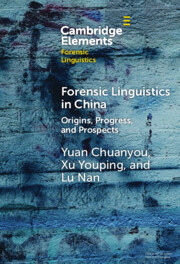Element contents
Forensic Linguistics in China
Published online by Cambridge University Press: 04 April 2024
Summary
Information
- Type
- Element
- Information
- Series: Elements in Forensic LinguisticsOnline ISBN: 9781009162548Publisher: Cambridge University PressPrint publication: 02 May 2024
References
Accessibility standard: Unknown
Why this information is here
This section outlines the accessibility features of this content - including support for screen readers, full keyboard navigation and high-contrast display options. This may not be relevant for you.Accessibility Information
- 4
- Cited by
